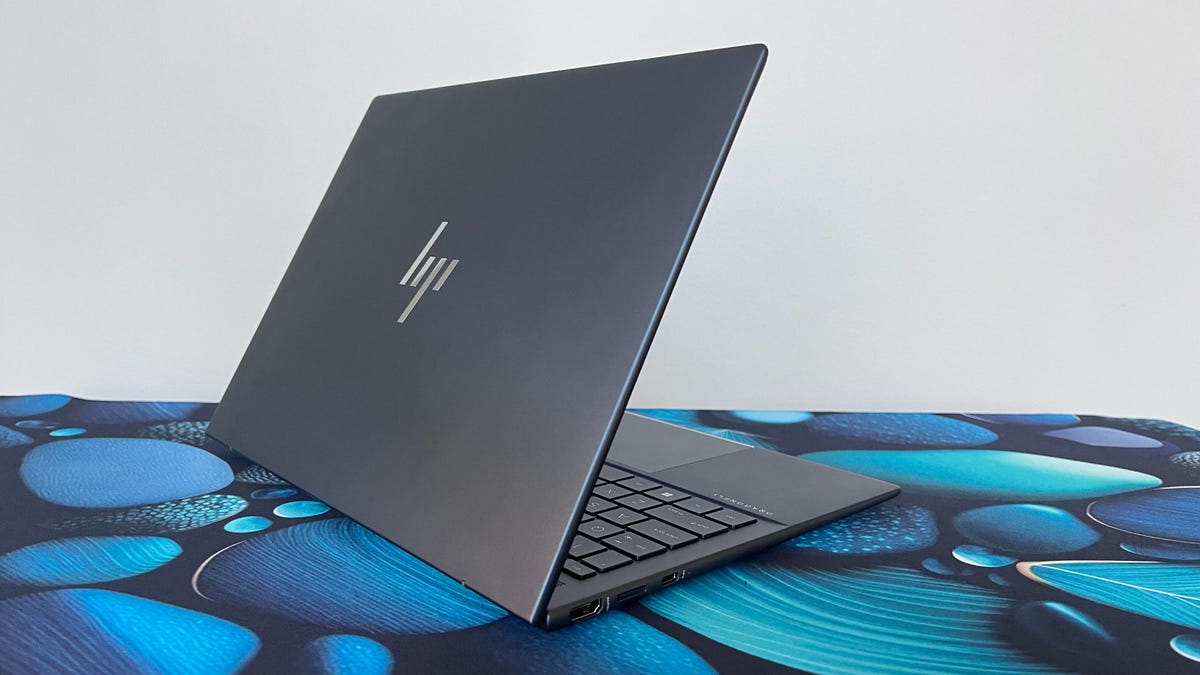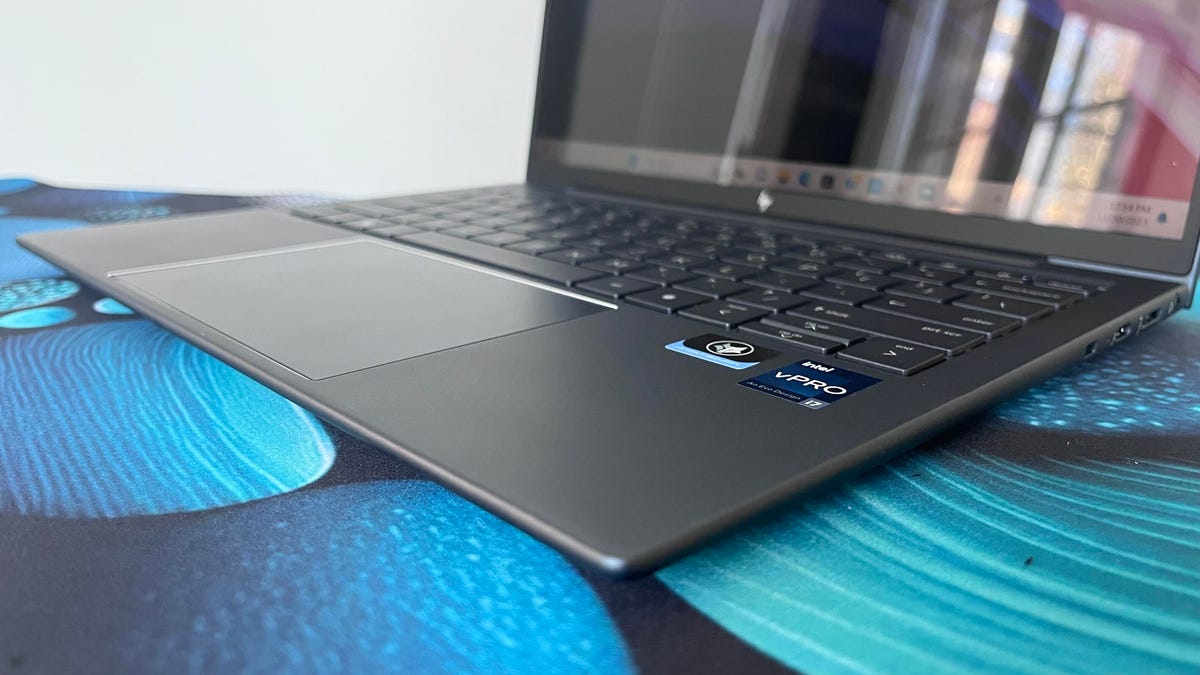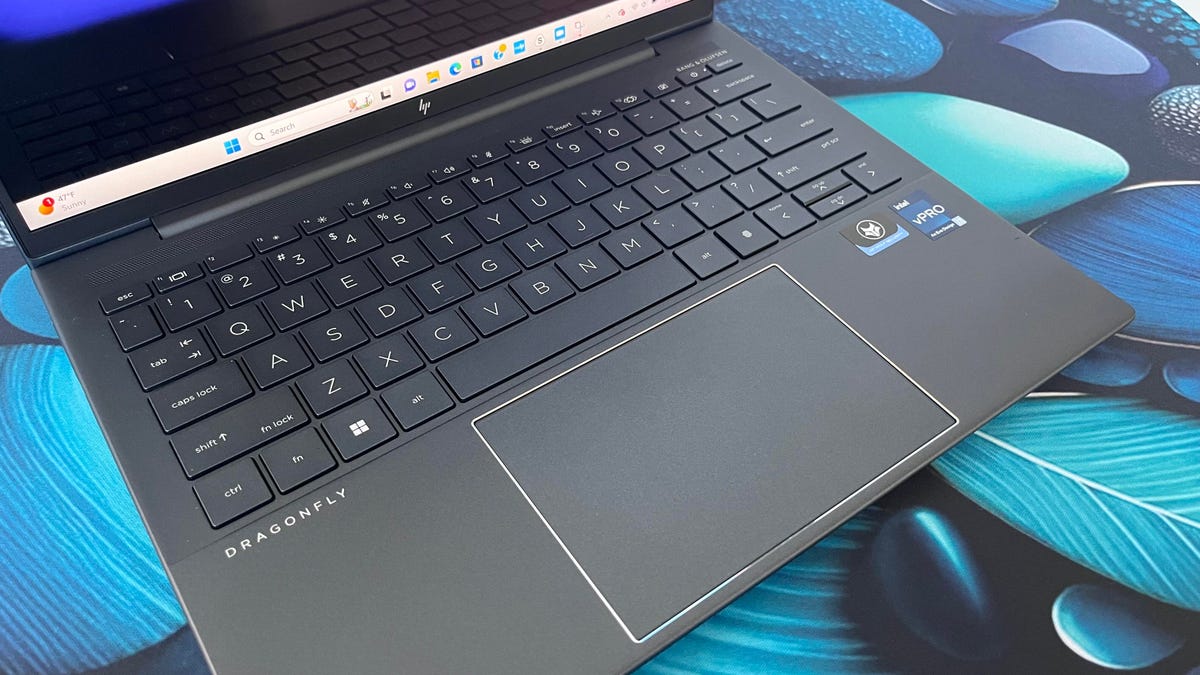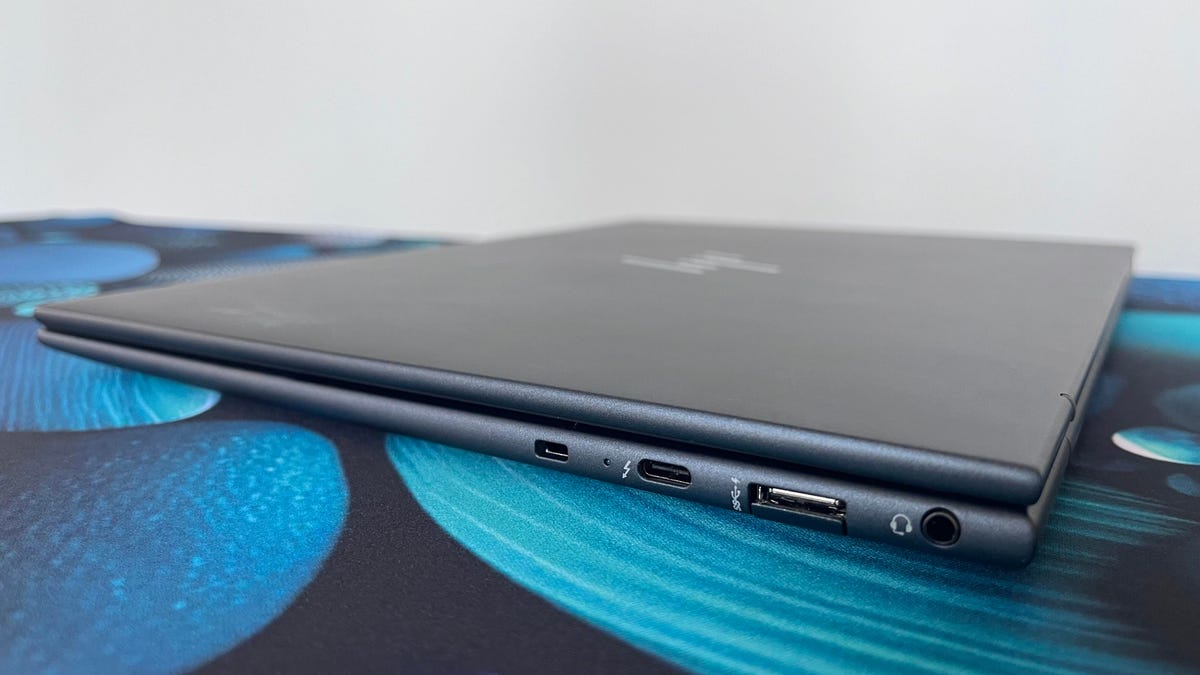The HP Dragonfly G4 is not your typical corporate machine. Trim and sleek, yet rigid and ready to withstand the abuses of business travel, it is every bit a premium C-suite business laptop. Its 13.5-inch display has an unusual boxy 3:2 aspect ratio, giving it more room from top to bottom, allowing you to read more lines of a document or web page while keeping the Dragonfly G4 compact and effortlessly portable. The little laptop also offers an uncommonly long battery life.
The most unusual inclusion, though, is the laptop’s support for dual cameras. Along with its built-in webcam above the display, a second webcam can be attached and used simultaneously to liven up your video conferences and in other ways, too. Dual webcams or not, there’s lots to like about the spiffy Dragonfly G4. It’s one of our favorite business ultraportables next to the Lenovo ThinkPad X1 Carbon Gen 11, but we highly recommend opting for the OLED upgrade that might actually save you money.
Configuration as tested
| Geekbox | HP Dragonfly G4 |
|---|---|
| Price as reviewed | $1,490 |
| Display size/resolution | 13.5-inch 1,920×1,280 non-touch IPS LCD |
| CPU | 1.8GHz Core i7-1365U |
| Memory | 16GB LPDDR5 6,400MHz |
| Graphics | 128MB Intel Iris Xe graphics |
| Storage | 512GB NVMe SSD |
| Networking | Wi-Fi 6E 802.11ax, Bluetooth 5.3 |
| Operating system | Microsoft Windows 11 Pro |
The HP Dragonfly G4 is based on 13th-gen Intel Core U-series processors. The baseline model features a Core i5-1335U CPU, 16GB of RAM, a 512GB SSD and a 13.5-inch IPS LCD display with a 1,920×1,280-pixel resolution. It’s difficult to pin down pricing with an HP laptop because the company constantly rotates discounts on its site. The baseline model at the time of this review was $1,099. Our review unit features a CPU upgrade to a Core i7-1365U chip and costs $1,490 — a steep increase for a slight bump in processing speed.
Both chips feature 10 processing cores (two performance cores and eight efficiency cores) and 12 processing threads. The best option, however, in the Dragonfly G4 lineup is the model selling for $1,249 that features a Core i7-1355U that’s nearly identical to the i7-1365U in our test system but supplies an OLED display with a 3,000×2,000-pixel resolution. Why choose our $1,490 test system when you can step into a higher-resolution OLED panel and save nearly $250 in the process? We’re not sure, but basically, you may need to decode configurations and patiently wait for a sale to get the most for your money.
The Dragonfly G4 with the OLED display is available in the UK for £1,673.99. In Australia, a model very similar to our test system sells for AU$3,299.

OLED option, dual webcam support
This is the second HP Dragonfly laptop I’ve looked at this year. I liked the similarly designed HP Dragonfly Pro when I reviewed it last spring. The Dragonfly Pro is geared toward freelancers and hybrid employees with built-in support buttons, whereas the Dragonfly G4 is made for larger businesses. It lacks the dedicated support buttons of the Dragonfly Pro, which I view as a positive since they felt forced. The Dragonfly G4, however, is not without security features. It has HP’s Wolf Security suite that features hardware-enforced threat detection, malware isolation and BIOS and browser protection, along with the ability to remotely lock and wipe the system if it’s lost or stolen.
I like the crisp, squared-off edges of the Dragonfly Pro better than the rounded edges of the Dragonfly G4, but the G4 is still a good-looking laptop. The matte-black chassis is elegant, and it’s made from a 90% recycled magnesium alloy. It weighs just 2.5 pounds, which is the same as the 14-inch Lenovo ThinkPad X1 Carbon Gen 11 and lighter than the 13.6-inch M2 MacBook Air (2.7 pounds) and 13.4-inch Dell XPS 13 (2.6 pounds). It’s also considerably lighter than the 14-inch Dragonfly Pro, which weighs 3.4 pounds.
The Dragonfly G4 is light without feeling cheap or flimsy. It’s solid, with hardly any flex in the keyboard deck or lid. And the matte finish not only looks sharp, but it’s also pleasing to the touch. There’s a very fine grit to the laptop’s matte-black surfaces that I really like. The matte surfaces are also excellent at repelling fingerprints and smudges.

The Dragonfly G4 is narrower and a bit deeper than most laptops we review. The majority feature a display with a 16:10 aspect ratio, but the Dragonfly G4 offers up a taller and boxier 3:2 ratio. It’s the spiritual opposite of a widescreen 16:9 laptop.
On a business laptop, it’s a good fit because the extra vertical space means you can read more and scroll less. There’s a reason you won’t find a 3:2 display on a laptop meant for home use: it’s less than ideal for watching shows and movies because they appear smaller than they would on a similarly sized 16:10 or especially a 16:9 screen. The taller display results in large black bars on the top and bottom of whichever video player you use.
Our test system features an IPS panel with a 1,920×1,280-pixel resolution. It suffices for the display size, but the text could be sharper. If your job requires you to read through documents for long stretches, then the upgrade to the OLED panel makes sense just for the bump in resolution alone. As it is, the baseline IPS display is very average. With mediocre color coverage, our test system’s display is better for scanning emails and working on spreadsheets than any creative endeavor. In testing with a Spyder X Elite colorimeter, the display covered 99% of the sRGB space but only 75% of AdobeRGB and 76% of P3.
The display did, however, match its brightness rating. Rated for 400 nits, it hit a peak brightness of 405 nits in testing. It also exhibited wide viewing angles. Still, when HP offers a higher-resolution OLED display option for hundreds less, it’s a no-brainer to punt on the baseline display of our test system in favor of the superior contrast and finer resolution that the OLED option affords.

The built-in webcam has a 1440p resolution and produces crisp, grain-free images with accurate skin tones. It also has an IR sensor for easy, secure logins via facial recognition. It’s great all by itself, but the Dragonfly G4 lets you double down. HP claims the Dragonfly G4 is the first business laptop to offer simultaneous support of dual webcams. It’s the first laptop — consumer or business — that I’ve used that lets you set up a two-camera shoot.
I connected a Microsoft webcam to the laptop, and was up and running immediately. With the myHP app, you can choose from a handful of layouts for the twin cameras. You can choose a picture-in-picture view or a split view (50/50 or 70/30) of the cameras, but the most interesting option is the view that switches between each camera, depending on which one you’re looking at. Granted, the audience is fairly small for this feature, but it could be a fun way to spice up your Zoom calls. It could also be useful for, say, tutorials where you want to remain in the frame while also keeping the focus on the object of the lesson.
Great keyboard, big battery
Given the thin enclosure, I expected less of the keyboard, but the keys offer surprisingly deep travel and snappy feedback. The keys are also very quiet when pressed, even for a heavy typist like this reviewer. I loved typing on the Dragonfly G4. The touchpad, too, is excellent. It’s generously proportioned for this size of laptop; the 3:2 display helps in this regard because it allows for a deeper wrist rest. The touchpad felt accurate, and its click response was firm and quiet with just the right amount of travel.

The audio output was also a pleasant surprise, a rarity among ultraportables where a pair of underpowered stereo speakers is the norm. The Dragonfly G4 offers a quad-speaker array that emits fuller sound than most ultraportable laptops. Bass response is predictably lacking, but the audio output has enough power and separation for shows and movies.
The Dragonfly G4 also supplies a generous port selection for an ultraportable. You get a pair of Thunderbolt 4 ports as well as a USB-A port along with an HDMI port and combo audio jack. The only adapter you might need is a USB-C-to-Ethernet since the laptop lacks an Ethernet port. There’s also a SIM card slot if you choose one of the Dragonfly G4’s WWAN options.

Most ultraportables feature a small, three-cell battery, but the Dragonfly G4 serves up a six-cell, 68-watt-hour battery. Combined with the efficient 15-watt, U-series Core i7 processor, the Dragonfly G4 delivers excellent battery life. It lasted 14.5 hours on our online streaming video battery drain test. That’s more than enough to get you through the longest of workdays without needing to charge. It’s also a long enough runtime that there’s room to sacrifice a bit for the higher-resolution OLED display that will almost assuredly have a negative impact on battery life.
On the rest of our tests, the Dragonfly G4 performed as expected. With a Core i7 U-series chip and integrated Intel graphics, it’s built for productivity work rather than creative work, but it has more than enough muscle for office tasks and a smooth Windows experience overall. I never ran into any lags or slowdowns, even when multitasking, and it stayed cool and quiet during operation.
The Lenovo ThinkPad X1 Carbon Gen 11 is still the best pick for business execs looking for a premium ultraportable, but the HP Dragonfly G4 is a close second. Both laptops offer strong build quality and OLED display options, but the ThinkPad X1 Carbon gets the nod because it offers a slightly roomier display in the admittedly more useful 16:10 aspect ratio without being any heavier than the Dragonfly G4. The ThinkPad also has a superior keyboard, though I did like the HP’s quite a bit. And, the Dragonfly G4 offers better battery life and the unique dual-webcam setup. You might also appreciate its clean design if the basic ThinkPad look doesn’t excite you.
How we test computers
The review process for laptops, desktops, tablets and other computer-like devices consists of two parts: performance testing under controlled conditions in the CNET Labs and extensive hands-on use by our expert reviewers. This includes evaluating a device’s aesthetics, ergonomics and features. A final review verdict is a combination of both objective and subjective judgments.
The list of benchmarking software we use changes over time as the devices we test evolve. The most important core tests we’re currently running on every compatible computer include: Primate Labs Geekbench 5, Cinebench R23, PCMark 10 and 3DMark Fire Strike Ultra.
A more detailed description of each benchmark and how we use it can be found in our How We Test Computers page.
Show Less
Geekbench 6 (multicore)
Acer Swift Go 1412,833Apple MacBook Air 159,859HP Dragonfly Pro9,322HP Dragonfly G48,709Lenovo ThinkPad X1 Carbon Gen 118,528Asus Expertbook B94507,817NOTE: Longer bars indicate better performance
PCMark 10 Pro Edition
Acer Swift Go 146,196HP Dragonfly Pro6,085Lenovo ThinkPad X1 Carbon Gen 115,639HP Dragonfly G45,131Asus Expertbook B94505,093NOTE: Longer bars indicate better performance
Cinebench R23 (multicore)
Acer Swift Go 1412,789HP Dragonfly Pro12,696Apple MacBook Air 158,721Lenovo ThinkPad X1 Carbon Gen 118,237HP Dragonfly G45,956Asus Expertbook B94505,348NOTE: Longer bars indicate better performance
3DMark Wild Life Extreme Unlimited
Apple MacBook Air 156,876Acer Swift Go 144,116HP Dragonfly Pro3,790Asus Expertbook B94503,633Lenovo ThinkPad X1 Carbon Gen 113,563HP Dragonfly G43,332NOTE: Longer bars indicate better performance
Online streaming battery drain test
Apple MacBook Air 15991HP Dragonfly G4870Lenovo ThinkPad X1 Carbon Gen 11775Asus Expertbook B9450739Acer Swift Go 14563HP Dragonfly Pro449NOTE: Longer bars indicate better performance
System configurations
| HP Dragonfly G4 | Microsoft Windows 11 Pro; 1.8GHz Core i7-1365U; 16GB DDR5 6,400MHz RAM; 128MB Intel Iris Xe graphics; 512GB SSD |
|---|---|
| Asus Expertbook B9450 | Microsoft Windows 11 Pro; 1.7GHz Intel Core i7-1255U; 16GB DDR5 6,400MHz RAM; 128MB Intel Iris Xe graphics; 1TB SSD |
| Lenovo ThinkPad X1 Carbon Gen 11 | Microsoft Windows 11 Pro; 1.7GHz Intel Core i7-1355U; 16GB DDR5 6,400MHz RAM; 128MB Intel Iris Xe graphics; 1TB SSD |
| Acer Swift Go 14 (SFG14-71) | Microsoft Windows 11 Home; 2.4GHz Intel Core i7-13700H; 16GB DDR5 4,766MHz RAM; 128MB Intel Iris Xe graphics; 512GB SSD |
| HP Dragonfly Pro | Microsoft Windows 11 Home; 2.7GHz AMD Ryzen 7 7736U; 16GB DDR5 6,400MHz; 512MB AMD Radeon graphics; 512GB SSD |
| Apple MacBook Air 15 | Apple MacOS 13.4.1 Ventura; 3.4GHz Apple M2; 16GB DDR5 RAM; Integrated 10-Core GPU; 512GB SSD |
